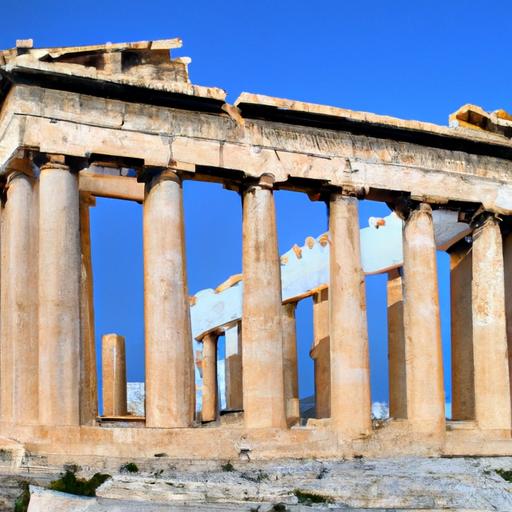Athens’ Acropolis: Greek Antiquity


– How was the Acropolis constructed and what materials were used?
Title: Athens’ Acropolis: Exploring the Wonders of Greek Antiquity
Introduction:
The Acropolis of Athens stands as a symbol of ancient Greek civilization and is one of the most recognizable landmarks in the world. Perched high above the modern city of Athens, this monumental site is a UNESCO World Heritage site and a testament to the rich history and cultural heritage of Greece. In this article, we will delve into the wonders of the Acropolis, exploring its history, significance, and architectural marvels.
History of the Acropolis:
The Acropolis has a long and storied history, dating back to the 5th century BC when it was built as a sacred site dedicated to the goddess Athena, the patron deity of Athens. Over the centuries, the Acropolis served as a religious center, a fortress, and a symbol of Greek power and civilization. It was during the Golden Age of Athens in the 5th century BC that the famous Parthenon, the iconic temple dedicated to Athena, was built on the Acropolis, along with other magnificent structures such as the Erechtheion and the Temple of Athena Nike.
Significance of the Acropolis:
The Acropolis holds immense cultural and historical significance for Greece and the world. It is considered the birthplace of democracy and the cradle of Western civilization, as well as a symbol of artistic and architectural excellence. The Acropolis serves as a reminder of the achievements of ancient Greece in art, philosophy, and science, and continues to inspire awe and admiration in visitors from around the globe.
Architectural Marvels of the Acropolis:
The Acropolis is home to some of the most iconic and well-preserved ancient Greek structures, including:
- The Parthenon: The most famous and impressive temple on the Acropolis, dedicated to the goddess Athena.
- The Erechtheion: A temple with the famous Porch of the Caryatids, featuring columns sculpted in the form of women.
- The Temple of Athena Nike: A small but elegant temple dedicated to Athena as the goddess of victory.
- The Propylaea: A monumental gateway leading to the Acropolis, showcasing impressive Doric columns and architectural symmetry.
Practical Tips for Visiting the Acropolis:
When visiting the Acropolis, there are a few tips to keep in mind to enhance your experience:
- Wear comfortable shoes and clothing, as there is a fair amount of walking and climbing involved.
- Visit early in the morning or late in the afternoon to avoid the crowds and the heat.
- Consider hiring a tour guide to gain a deeper understanding of the history and significance of the site.
Benefits of Exploring the Acropolis:
Exploring the Acropolis offers a range of benefits, including:
- Immersing oneself in ancient Greek history and culture.
- Gaining a greater appreciation for the architectural and artistic achievements of the ancient Greeks.
- Experiencing breathtaking views of the city of Athens from the elevated vantage point of the Acropolis.
Conclusion:
The Acropolis of Athens is a testament to the enduring legacy of ancient Greek civilization and a must-see destination for anyone interested in history, art, and culture. By exploring the wonders of the Acropolis, visitors can gain a deeper appreciation for the achievements of the ancient Greeks and marvel at the architectural masterpieces that have stood the test of time. Plan your visit to the Acropolis today and immerse yourself in the splendor of Greek antiquity.
In conclusion, the Acropolis of Athens stands as a beacon of Greek antiquity, offering visitors a glimpse into the rich history and cultural heritage of Greece. By exploring its architectural marvels and understanding its significance, visitors can gain a deeper appreciation for the achievements of ancient Greece and the enduring legacy of the Acropolis. Plan your visit to this iconic site and experience the wonders of Greek antiquity firsthand.
Athens’ Acropolis: Exploring the Treasures of Greek Antiquity
Greece is a country steeped in history, boasting an ancient civilization that has left an indelible mark on the world. Among the countless wonders that Greece offers, the Acropolis of Athens stands out as a testament to the brilliance and ingenuity of Greek architecture and engineering. Built atop a hill overlooking the city of Athens, the Acropolis is a must-see destination for anyone interested in exploring Greek antiquity. In this article, we will dive into the history and significance of the Acropolis of Athens, as well as offer practical tips for visitors looking to make the most of their experience.
History of the Acropolis
The word ‘acropolis’ translates to ‘high city’ in Greek, and it refers to the ancient citadels that were built on elevated or rocky terrain for defensive purposes. The Acropolis of Athens is the most famous of these structures, and its construction dates back to the 5th century BC. The site was initially used as a religious sanctuary, with many temples and cult statues housed within its walls. However, it later became a symbol of political and military power for the city-state of Athens.
The most iconic building on the Acropolis is the Parthenon, which was built between 447 and 438 BC. This temple dedicated to the goddess Athena is considered a symbol of classical Greece and is renowned for its perfect proportions and architectural brilliance. The Propylaea, the entrance to the Acropolis, and the Erechtheion, a temple with six Caryatid statues, are two other notable structures on the site.
The Acropolis was a thriving hub of activity for centuries, but it fell into disrepair after it was occupied by various conquerors. In 1834, the newly independent Greek state launched a restoration project that continues to this day. The Acropolis was declared a UNESCO World Heritage Site in 1987, and it remains an essential part of Greek cultural identity.
Exploring the Acropolis
A visit to the Acropolis of Athens is like stepping back in time to experience the grandeur of Greek architecture and art. Visitors can see the remains of ancient structures, such as the Temple of Athena Nike, and marvel at the intricate details and designs that have withstood the test of time. But before you plan your trip to the Acropolis, here are some practical tips to keep in mind:
1. Plan ahead: The Acropolis is a popular tourist destination, so it’s best to plan your visit in advance to avoid long lines and crowds. Consider purchasing tickets online or arriving early in the morning when the site opens to the public.
2. Wear comfortable shoes: The Acropolis is perched on a steep hill, and there are many uneven pathways and stairs to climb. Be sure to wear comfortable, sturdy walking shoes to make your ascent easier.
3. Bring water and sun protection: The Acropolis is an open-air site, and it can get scorching hot during the summer months. Bring plenty of water and sunscreen to stay hydrated and protected from the sun’s rays.
4. Hire a guide: To truly appreciate the history and significance of the Acropolis, consider hiring a knowledgeable guide who can provide valuable insights and information.
The Benefits of Visiting the Acropolis
Aside from being a historical and cultural treasure, the Acropolis offers visitors many benefits. Here are some reasons why a trip to the Acropolis should be on your travel list:
1. Cultural immersion: From the ancient structures to the intricate details on the sculptures, the Acropolis offers a unique opportunity to immerse yourself in Greek culture.
2. Educational experience: Visiting the Acropolis is a great way to learn about Greek history and architecture. It’s also an excellent opportunity for children to understand and appreciate the past in a fun and engaging way.
3. Stunning views: As one of the highest points in Athens, the Acropolis offers breathtaking views of the city below.
Case Study: The Importance of Architectural Restoration
The ongoing restoration project of the Acropolis serves as a crucial case study for the world. It showcases the importance of preserving and restoring ancient structures for future generations to appreciate and learn from. The careful and meticulous restoration efforts have allowed the Acropolis to remain a tangible link to our past and continue to inspire awe and wonder in visitors.
First-hand Experience: A Journey Through Time
Visiting the Acropolis of Athens is an unforgettable journey through time. It’s a chance to walk in the footsteps of ancient Greeks, marvel at their achievements, and be awestruck by the sheer grandeur of it all. The towering columns, intricate sculptures, and magnificent buildings are a testament to the enduring legacy of Greek antiquity.
In Conclusion
The Acropolis of Athens is a must-see destination for anyone interested in Greek history and culture. Its historical and cultural significance, combined with its breathtaking beauty, makes it a top attraction in Greece and the world. By planning ahead, dressing comfortably, and hiring a knowledgeable guide, visitors can make the most of their experience at the Acropolis. So, if you’re planning a trip to Greece, be sure to add the Acropolis to your itinerary and embark on a journey through the wonders of Greek antiquity.





